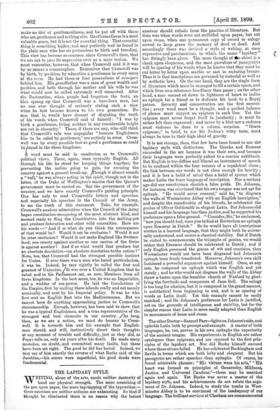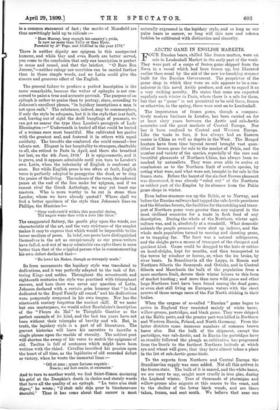THE LAPIDARY STYLE.
WRITING, alone of the arts, needs neither dexterity of hand nor physical strength. The mere scratching of the pen upon paper, the mere tap-tapping of the typewriter,— these exercises are neither arduous nor exhausting. So that if thought be eliminated there is no reason why the laziest amateur should refrain from the practice of literature. But time was when words were not scribbled upon paper, but cut upon stone, when one permanent copy of record or eulogy served to keep green the memory of deed or dead. And accordingly there was devised a style of writing, at once expressive and parsimonious, to which the name " lapidary " has fittingly been given. The mere thought of Ike chisel is a check upon eloquence, and the most garrulous of panegyrists will be sparing of his words when he knows that they must be cut letter by letter upon marble or cast in enduring bronze. Thus it is that inscriptions are governed by material as well as by msthetic laws. On the one hand, they are the single form of literature which must be arranged to fill a certain space, and which lives on a substance less flimsy than paper ; on the other hand, a man cannot sit down in lightness of heart to indite an epitaph for a friend or to dedicate his book to a Royal patron. Severity and concentration are the first necessi- ties; every word must be a thought, and a perfect balance of prase must suggest an epigram in each line. Yet the epigram must never forget itself in jocularity; it must be rather felt than expressed ; and never by a hint nor a cadence must violence be done to a solemn occasion. "Grave epigrams," in brief, to use Sir Joshua's witty term, must always be true to their high ideal of gravity.
It is not strange, then, that few have been found to use the lapidary style with distinction. The Greeks and Romans succeeded in the art because it was their own, and because their languages were perfectly suited to a concise antithesis. But English is too diffuse and liberal an instrument of speech to be confined within the four corners of a sepulchral stone; the link between our words is not close enough for brevity ; and it is less a habit of mind than a habit of syntax which makes Latin the truer language of inscription. Nor a century ago did our countrymen cherish a false pride. Dr. Johnson, for instance, was convinced that his own tongue was not apt for epitaph. "He would never consent," said he, "to disgrace the walls of Westminster Abbey with an English inscription," and despite the round-robin of his friends, he celebrated the genius of Oliver Goldsmith in elegant Latin. But Johnson did himself and his language less than justice, and he supported his preference upon a false ground. "Consider, Sir," he exclaimed, "how you should feel, were you to find at Rotterdam an epitaph upon Erasmus in Dutch." So he would have all inscriptions written in a learned language, that they might both be univer- sally understood, and secure a classical stability. But if Dutch be suited to commemorate the triumphs of genius, we would rather that Erasmus should be celebrated in Dutch ; and if only English possessed the graces of wit and concision, then Westminster would not have been disgraced had Johnson's epitaph been freely translated. Moreover, Johnson's own skill fashioned a powerful argument against himself. Once, at any rate, he composed an epitaph which was English and yet stately ; and he who would not disgrace the walls of the Abbey threw a lustre upon the humbler church of Watford by glori- fying the fortitude and composure of Jane Bell. The eulogy is too long for citation, but it is composed in the grand manner, is antithetical from beginning to end, and is as sparing of words as Latin itself. Yet this example cannot be easily matched ; and Dr. Johnson's preference for Latin is justified, not on the grounds of intelligence and stability, but for the simpler reason that Latin is more easily adapted than English to monuments of brass and stone.
The other Doctor—Samuel Parr—fights on Johnson's side, and upholds Latin both by precept and example. A master of both languages, he, too, proves in his own epitaphs the superiority of the ancient tongue. His experiments in English are rather catalogues than epigrams, and are opposed to the first prin- ciples of the lapidary art. Nor did Burke himself succeed where these others failed. He has celebrated Rockingham and Saville in terms which are both lofty and eloquent. But his panegyrics are rather speeches than epitaphs. Of course, he found admirable phrases: "His virtues were his arts," "His heart was formed on principles of Generosity, Mildness, Justice, and Universal Candour,"—these may be matched again and again. Yet Burke was never a master of the lapidary style, and his achievements do not refute the argu- ment of Dr. Johnson. Indeed, to study the tombs in West- minster Abbey is to be conNinced of the inadequacy of our language. The brilliant services of Chatham are commemorated in a common statement of fact ; the merits of Mansfield are thus unwittingly held up to ridicule :— " Hem Murray, long enough his country's pride, Is now no more than Tully or than Hyde. Foretold by Az. Pope, and fulfilled in the year 1773."
There is neither dignity nor epigram in this unexpected humour, and while Gay and even Booth are better served, you come to the conclusion that only one inscription is perfect in sense and sound, and that the briefest. "0 Rare Ben Jonson,"—neither eulogy nor concision can be carried further than in those simple words, and no Latin could give the sincere and generous effect of the English.
The general failure to produce a perfect inscription is the more remarkable, because the writer of epitaphs is not con- cerned to paint a true and accurate portrait. The purpose of an epitaph is rather to praise than to portray, since, according to Johnson's excellent phrase, "in lapidary inscriptions a man is not upon oath." The substance, indeed, may be commonplace, if only the style be adequate, but it is the style that is at fault, and, leaving out of sight the droll bunglings of peasants, we can get no nearer the type than Landor's panegyric of Lady Blessington :--" Underneath is buried all that could be buried of a woman once most beautiful. She cultivated her genius with the greatest zeal, and fostered it in others with equal assiduity. The benefits she conferred she could conceal—her talents not. Elegant in her hospitality to strangers, charitable to all, she retired to Paris in April, and there she breathed her last, on the 4th June, 1849." It is epigrammatic, and it is grave, and it appears admirable until you turn to Landor's own Latin, when the inferiority of English is confessed at once. But while English prose is too often at fault, English verse is perfectly adapted to panegyrise the dead, or to sing the praise of the living. The cadence of the verse, the enforced pause at the end of the line make for epigram, and if we cannot rival the Greek Anthology, we may yet boast our masters. Who is more worthy to be cut in stone than Landor, whom we have already quoted 1 Where shall we find a better specimen of the style than Johnson's lines on Phillips, the Musician?— " Sleep undisturb'd within this peaceful shrine,
Till angels wake thee with a note like thine."
The exaggerated flattery, the gentle play upon the words, are characteristic of the art, and the very strictness of the couplet makes it easy to express that which would be impossible to the looser medium of prose. In brief, our poets have distinguished themselves in the art as conspicuously as our prose-writers have failed, and out of many admirable examples there is none better than that of the crippled parson who in commemorating his own defect declared that— "Re loved his Maker, though so strangely made."
So from monuments the lapidary style was translated to dedications, and it was perfectly adapted to the task of flat- tering Kings and nobles. Throughout the seventeenth and eighteenth centuries the style was practised with triumphant success, and here there was never any question of Latin. Johnson declared with a certain grim humour that "he had dedicated to the Royal Family all round," and his dedications were pompously composed in his own tongue. Nor has the nineteenth century forgotten the ancient skill. If we name but one masterpiece, we would select Baudelaire's inscription of the " Fleurs du Mal" to Theophile Gautier as the perfect example of its kind, and the last ten years have not been without their triumphs of brevity and wit. But, in truth, the lapidary style is a part of all literatures. The gravest historian will leave his narrative to inscribe a single phrase upon the marble of eternity. The noblest poet will shorten the sweep of his verse to match the epigrams of old. Tacitus is full of sentences which might have been written with the chisel. Catullus inscribed his passion upon the heart of all time, as the lapidaries of old recorded defeat or victory, when he wrote the immortal lines :— " ()di et amo ; (pare fortasse requiris Nescio ; sed fieri sentio, et excracior."
And to turn to another world, we find Saint-Simon declaring his grief at the Dauphin's death in choice and stately words that have all the quality of an epitaph. "La terre n'en etoit digne," he wrote ; "Ii etoit mfir deja pour in bienheureuse eternite." Thus it- has come about that sorrow is most naturally expressed in the lapidary style, and so long as our pulse beats to sorrow, so long will this rare and solemn fashion be cultivated with distinction and sincerity.























































 Previous page
Previous page